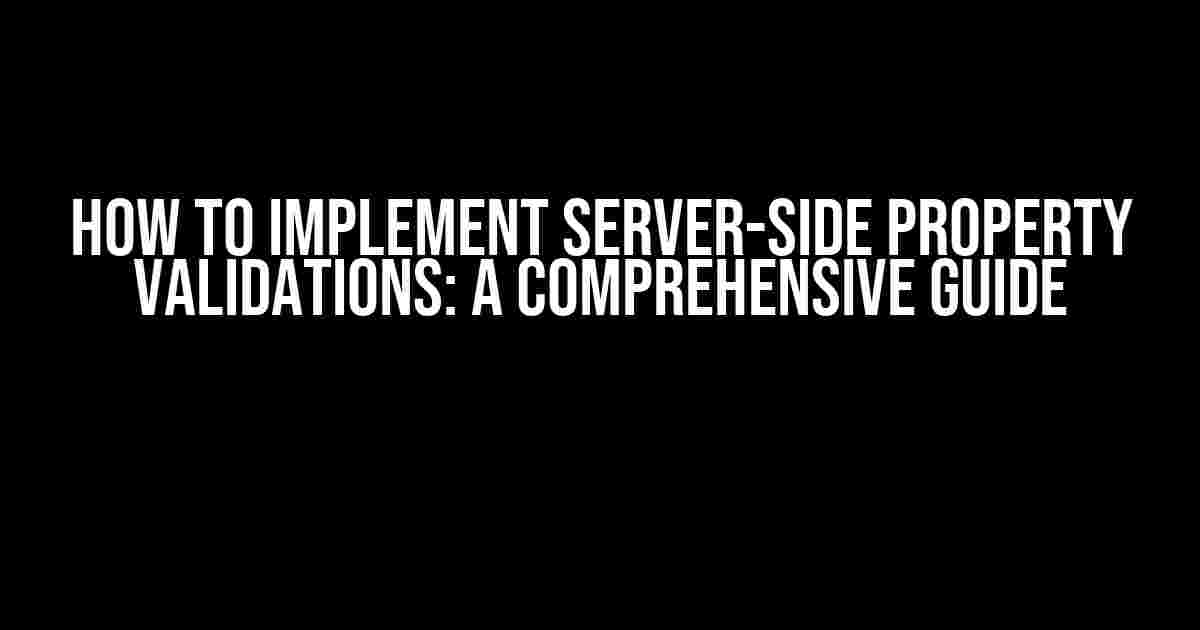Server-side property validations are an essential aspect of building robust and secure web applications. By validating user input on the server-side, you can ensure that your application remains protected from malicious attacks and data corruption. In this article, we’ll take you through the process of implementing server-side property validations, providing clear and direct instructions to help you get started.
Why Server-Side Property Validations Matter
Client-side validations are essential, but they can be easily bypassed by malicious users. That’s why it’s crucial to implement server-side property validations to ensure that your application remains secure. Here are some reasons why:
- Malicious users can easily tamper with client-side validations using tools like developer tools or proxy servers.
- Client-side validations can be circumvented by disabling JavaScript or using older browsers.
- Server-side validations provide an additional layer of security, ensuring that your application remains protected even if client-side validations are bypassed.
Understanding Property Validations
Property validations involve checking user input against a set of rules or constraints to ensure that it meets specific requirements. These requirements can include:
- Data type (e.g., string, integer, date)
- Data format (e.g., email, phone number, credit card number)
- Data length or size
- Data range or boundaries
- Pattern matching (e.g., password strength, username format)
Implementing Server-Side Property Validations
To implement server-side property validations, you’ll need to follow these steps:
- Define Validation Rules: Determine the validation rules for each property, considering the requirements mentioned earlier. For example, you may want to validate a username as a string with a minimum length of 3 characters.
- Choose a Validation Framework: Select a validation framework that suits your programming language and framework. Popular options include:
| Language/Framework | Validation Framework |
|---|---|
| Node.js/Express | Joi, Express-validator |
| Python/Django | Django’s built-in validation, Pydantic |
| Java/Spring | Bean Validation API, Hibernate Validator |
- Write Validation Code: Write code to validate each property using the chosen validation framework. For example, using Joi in Node.js:
const Joi = require('joi');
const schema = Joi.object().keys({
username: Joi.string().min(3).required(),
email: Joi.string().email().required(),
password: Joi.string().min(8).required()
});
const userInput = { username: 'john', email: 'john@example.com', password: 'password123' };
const result = Joi.validate(userInput, schema);
if (result.error) {
console.log(result.error.details);
} else {
console.log('Validation successful!');
}
- Handle Validation Errors: Handle validation errors by returning error messages or codes to the client, depending on your application’s requirements. For example:
if (result.error) {
res.status(400).json({ error: 'Invalid username or password' });
} else {
// Proceed with the request
}
Best Practices for Server-Side Property Validations
Follow these best practices to ensure that your server-side property validations are effective:
- Validate on Each Request: Validate user input on each request, rather than relying on cached data or previous validations.
- Use Whitelisting Instead of Blacklisting: Specify allowed input formats and patterns instead of blocking specific malicious inputs.
- Validate Both Client-Side and Server-Side: Implement both client-side and server-side validations to provide an additional layer of security.
- Use Secure Defaults: Use secure defaults for properties, such as encrypting sensitive data by default.
- Log and Monitor Validation Errors: Log and monitor validation errors to identify potential security threats and improve your application’s security posture.
Conclusion
Implementing server-side property validations is a crucial step in building robust and secure web applications. By following the steps and best practices outlined in this article, you can ensure that your application remains protected from malicious attacks and data corruption. Remember to define clear validation rules, choose a suitable validation framework, and write effective validation code to handle user input securely.
Don’t hesitate to explore more advanced topics, such as:
- Using ORM (Object-Relational Mapping) tools for validation
- Implementing custom validation rules using regex or other techniques
- Integrating validation with authentication and authorization mechanisms
By mastering server-side property validations, you’ll be well on your way to building a secure and reliable web application that meets the demands of modern web development.
Here are 5 Questions and Answers about “How to implement server-side property validations?” in HTML format:
Frequently Asked Question
VALIDATE LIKE A PRO! Get the lowdown on implementing server-side property validations and take your data integrity to the next level!
Q1: What are server-side property validations, and why are they important?
Server-side property validations are a set of rules that ensure the data entered by users meets specific criteria, such as format, length, and range. They’re essential because they prevent invalid data from entering your system, reducing errors, and improving overall data quality. Think of them as the guardians of your data!
Q2: What are some common validation rules used in server-side property validations?
Some common validation rules include: required fields, email addresses, phone numbers, passwords, dates, and numbers with specific formats. You can also create custom rules to fit your specific use case. The possibilities are endless!
Q3: How do I implement server-side property validations in my application?
You can implement server-side property validations using various programming languages and frameworks. For example, in Node.js, you can use modules like Joi or Express Validator. In .NET, you can use Data Annotations or FluentValidation. Research the best approach for your tech stack!
Q4: What are some best practices for implementing server-side property validations?
Some best practices include: defining clear validation rules, providing user-friendly error messages, validating data early and often, and testing thoroughly to ensure your rules are working as expected. Remember, validation is not just about blocking bad data, but also about providing a great user experience!
Q5: How do I handle validation errors and exceptions in my application?
When validation errors occur, catch and handle them gracefully! Display user-friendly error messages, log the errors for debugging, and consider implementing retry mechanisms or fallbacks. Remember, error handling is an art – make it a masterpiece!
